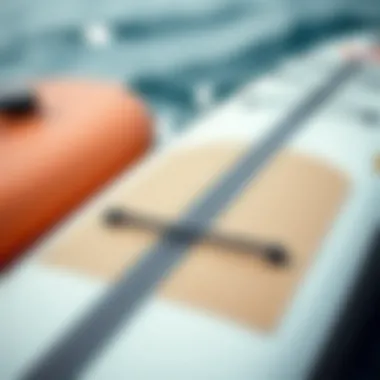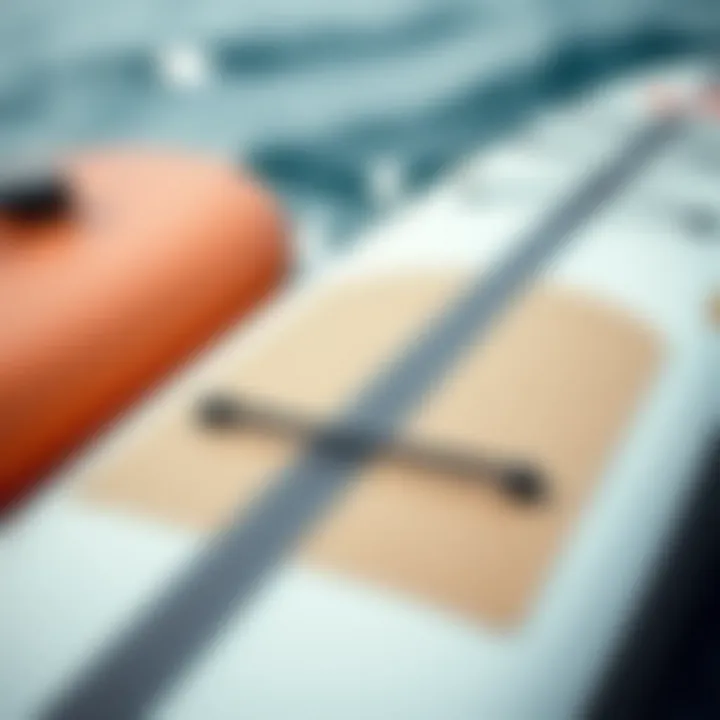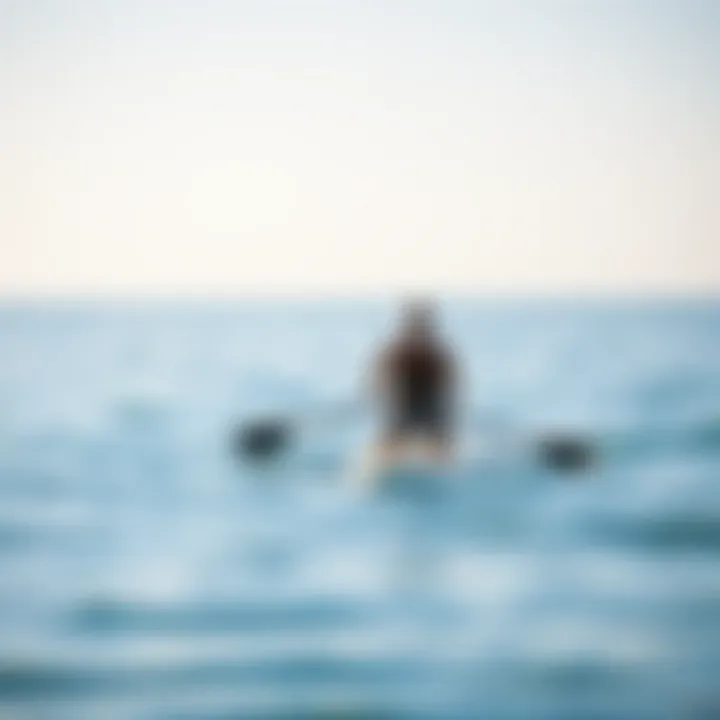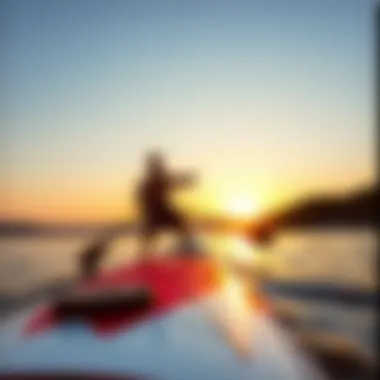Selecting the Ideal Paddle Board: Key Insights and Tips


Intro
Paddleboarding is not just a sport; it’s a journey on water, offering an escape into nature and a chance to connect with your surroundings. Choosing the right paddle board isn't merely a matter of preferences; it can significantly influence your performance, stability, and overall enjoyment. With so many options available, it’s easy to feel overwhelmed.
When it comes to paddling on lakes, oceans, or rivers, even the most seasoned water sports enthusiasts recognize the importance of making informed decisions. It goes beyond picking the most colorful board; understanding materials, types, and personal suitability can elevate your experience from good to exceptional.
This guide is designed to illuminate the path toward selecting the right paddle board. We’ll dissect various factors including board types, intended use, and essential gear. Let's embark on this exploration that promises to equip you with the insights needed to paddle like a pro.
Expert Insights
Latest Trends in Watersports
Watersports is constantly evolving; paddleboarding is no exception. Recently, there’s been a surge in inflatable paddle boards, which combine portability with performance. They're highly sought after due to their ease of storage and transportation.
Moreover, eco-conscious choices are gaining momentum. Manufacturers are integrating sustainable materials into their designs. As a result, boards made from biodegradable and recycled elements are now on the market, appealing to environmentally minded adventurers.
Keeping an eye on emerging technologies, many paddle boards now come equipped with features like integrated GPS systems and fitness trackers, adding a competitive edge to your outings.
Safety Protocols and Best Practices
While many riders relish the thrill of the waves, safety should always be the main course. Here are some best practices to ensure a safe paddle experience:
- Always wear a Personal Flotation Device (PFD): Some waterways even mandate this.
- Check local regulations and weather conditions: Know the tides and wind forecasts before heading out.
- Fish tailing: When paddling alone, consider keeping your distance from turbulent waters or large boats to avoid mishaps.
- Stay hydrated: Bring water for long excursions, especially under the sun.
"Safety is not just a checklist; it's a mindset to carry on every outing."
Equipped with knowledge and awareness of safety norms, you’ll not only protect yourself but also enhance your paddleboarding experience.
Equipment Recommendations
Must-Have Gear for Beginners
For newcomers to paddleboarding, the right gear can make a world of difference. Here are essentials you shouldn’t overlook:
- Beginner Board: Opt for a wider board, as it offers better stability.
- Paddle: Choose a lightweight paddle. A good rule of thumb is to have the paddle's height about 6-8 inches above your head.
- Leash: A leash connects you to your board, preventing it from floating away in case you fall.
- Life Jacket: As mentioned before, this isn’t just for safety — it’s a necessity in many locations.
Advanced Equipment for Pros
As skills develop, so can the equipment. For seasoned riders, consider these recommendations:
- Performance Board: Look for boards that are thinner and more streamlined for speed.
- Carbon Fiber Paddle: This material is lighter and enhances maneuverability.
- Hydration Pack: Staying hydrated is crucial for long-distance paddles — a pack allows hands-free access to water.
In summary, selecting the right paddle board and gear involves knowing your needs, skills, and the environments you'll explore. This guide serves as your compass, steering you toward informed decisions tailored to your paddling journey. For a more thorough grasp of paddleboarding equipment and safety, check out reliable resources like Wikipedia or Britannica.
Stay tuned as we continue exploring the nuances of paddleboarding in the following sections.
Understanding Paddle Board Basics
The world of paddle boarding can be a bit sprawling, potentially leaving newcomers feeling like they're navigating the high seas without a compass. Understanding paddle board basics is incredibly important because it lays the groundwork for making informed decisions later on. It touches on the history of paddle boards, helping enthusiasts appreciate how they evolved into the shapes and styles we see today. Moreover, knowing the terminology that comes with this sport can prevent confusion down the line and ensure that each paddler can communicate clearly about their preferences and experiences.
The Evolution of Paddle Boards
Paddle boards have come a long way since their inception. Initially, they were simple wooden planks used by ancient cultures for fishing and daily transport. Fast forward to today, and they come in an array of materials, sizes, and designs, each tailored for specific uses. The flexibility in design has enabled paddle boards to cater to various activities—from leisurely paddling in calm waters to high-speed racing and everything in between.
For instance, the rise of inflatable paddle boards in the early 2000s revolutionized the sport. They made paddle boarding more accessible by offering lightweight and portable options that anyone could store and transport easily. These boards have solidified their place in the market alongside traditional hard boards, appealing to a broad audience.
This evolution has not just been about materials or portability. Design elements like rocker, tail width, and nose shape have also undergone extensive innovation. Each tweak in design serves a specific purpose: increased stability, better tracking in the water, or improved speed.
Key Terminology in Paddle Boarding
Navigating the world of paddle boarding comes with its own set of jargon which might seem daunting at first. Familiarizing yourself with essential terms is vital to your paddle boarding journey. Here are some key concepts:
- Rocker: The curve of the board from nose to tail. A board with a lot of rocker is great for maneuverability in surf but may not track as well in flat water.
- Nose: The front part of the paddle board. The design of the nose can influence whether the board slices through waves or floats gracefully over them.
- Tail: The back end of the board. Different tail shapes offer various levels of speed and stability.
- Deck pad: The non-slip surface on which you stand. Its texture and material can impact comfort and grip while paddling.
- Fin setup: Fins are crucial for stability and tracking. Different setups (single, thruster, quad) can make a board behave quite differently in the water.
By grasping these terms, you’ll find it much easier to discuss your needs and preferences with peers or shop staff, ensuring you get the right board for your adventures.
Understanding paddle board basics not only enriches your knowledge about this exhilarating sport but serves as a solid foundation upon which to build your skills. With the right tools and insights, you’ll be better poised to dive deeper into selecting the board that suits your style you'll join countless others reaping the joy this activity provides.
Types of Paddle Boards
Selecting the right paddle board is pivotal in shaping your experience on the water. Understanding the various types of paddle boards available can significantly influence your enjoyment and performance, depending largely on your specific needs and intended use. Each type offers its own unique benefits, characteristics, and purposes, ensuring there's a suitable board for every paddler out there.


All-Around Paddle Boards
All-around paddle boards are often considered the Swiss Army knife of the paddle boarding world. These boards are designed for versatility, making them a solid choice for beginners and experienced paddlers alike. Typically wider and more stable than specialized boards, all-around boards can handle a variety of conditions, from flat lakes to mild coastal waves. They generally range from 10 to 12.6 feet in length.
When considering an all-around paddle board, look for features like a wide nose for better glide and stability, as well as a rounded tail for maneuverability. They can be used for various activities, such as fitness, leisure, or even light surfing. Keep in mind that if you're leaning towards a specific activity, such as yoga or racing, you might want to delve into a more focused option.
Touring and Expedition Boards
For those looking to embark on longer outings, touring and expedition boards are the way to go. These boards typically measure between 12.6 to 14 feet and are designed with a pointed nose that enhances speed while cutting through waves effectively. They often feature a narrower width compared to all-around models, making them more hydrodynamic but potentially less stable.
Considerations include how much gear you intend to carry, as some touring boards include rigging points for gear storage, allowing you to venture out for a full day or even overnight. While these boards are not generally suited for beginners, experienced paddlers will appreciate the speed and efficiency they bring to long-distance paddling.
Race Boards
Race boards are specialized for competitive paddling. These boards are built for speed, often being longer and more streamlined than other types, measuring anywhere from 12.6 to 20 feet. Their sleek design reduces drag and increases efficiency, making them optimal for anyone looking to shave seconds off their race times.
Many race boards also come with advanced features like water-tight compartments and built-in foot wells for added control during fast maneuvers. Choosing the right race board often depends on your weight and height, so some experimentation may be needed to find the perfect match.
Yoga Paddle Boards
If connecting with nature while practicing yoga sounds appealing, yoga paddle boards are specifically designed for balance and stability. These boards are typically wider and thicker than standard all-around boards, providing ample surface area for your poses.
Look for features such as non-slip decks and reinforced rails, as they help to ensure safety during your practice. One benefit of yoga from a paddle board is the serene backdrop of nature and the gentle rocking of the water, which can enhance your mindfulness during practice.
Inflatable vs. Hard Boards
The choice between inflatable and hard boards is one that often boils down to personal preference and intended use. Inflatable paddle boards (iSUPs) are highly portable. They can be deflated, rolled up, and packed away in a car trunk, making them ideal for storage and transport. Generally, they are cheaper to maintain and provide decent durability, although they may not offer the same level of performance as hard boards in terms of speed and stability.
On the flip side, hard boards are known for their responsiveness and speed, delivering better performance in rough waters. However, they require more storage space and can be cumbersome to transport. Consider your riding style and how often you intend to paddle when making your choice.
"Understanding the type of paddle board that suits your needs can transform your entire paddling experience. It’s the key to unlocking your potential on the water."
Finale
In summary, recognizing the different types of paddle boards is crucial in making an informed decision tailored to your paddling ambitions. While the all-around board offers flexibility, specialized boards like touring, race, and yoga boards cater to specific activities, ensuring that all paddlers find their niche. Additionally, weighing the benefits of inflatable versus hard boards will further refine your selection, paving the way for an enriching and thrilling paddleboarding journey.
Size and Dimensions
In the world of paddleboarding, size and dimensions of the board play a pivotal role in defining not just your experience on the water, but also your overall performance. Selecting the right size can enhance stability, influence speed, and adjust your efficiency in various water conditions. When you're out there slicing through the waves or gliding on a calm lake, the dimensions of your board can mean the difference between exhilaration and frustration.
Understanding Board Length
Board length is one of the primary specifications that you need to consider. Generally speaking, longer boards tend to offer more speed and better tracking in the water. These boards are ideal for athletes looking to race or anyone planning on longer voyages. For example, a board that measures 12'6" or 14' is typically favored in flat water racing scenarios.
Conversely, shorter boards, like those around 10' to 11', provide increased maneuverability, making them ideal for surfers or those who enjoy riding waves. In this case, it's important to think about your individual goals and the type of paddling you’ll be doing. As with many things, there is no one-size-fits-all solution. A happy medium for recreational use usually lands between these lengths, depending on your body size and weight.
Board Width Considerations
Width is another essential factor that can greatly influence how your board performs. Wider boards, often ranging from 30 inches to 34 inches, typically offer enhanced stability. This quality can be beneficial for beginners who are still finding their balance on the water. A board like the BIC Sport ACE-TEC may feature a wider profile, allowing for more confidence with those first few strokes.
On the flip side, narrower boards, usually 28 inches or less, cut through the water with improved speed but at the cost of stability. If you’re in advanced paddleboarding terrain like choppy waters, a narrow board could provide added responsiveness, but not without a trade-off in stability. So, if you enjoy the thrill of racing but still appreciate a bit of stability, consider your preferred width carefully.
Thickness and Volume
Thickness and overall volume go hand-in-hand when you're assessing how a board will perform with your weight. A thicker paddle board can accommodate more weight and thus offers a larger buoyancy. Boards designed with increased thickness, generally two to four inches, often range in volume. This affects how they respond in water and can either stabilize your ride or leave you feeling more wobbly.
For example, if you're a heavier rider or just want a more stable board, opting for something with a thickness of around four inches could be the way to go. It ensures that you have adequate flotation and reduces the chances of the board sinking, particularly in rough waters. If you're lighter or focusing more on speed, you might find a thinner board feels zippier and less cumbersome.
"Understanding your specific needs concerning size and dimensions can dramatically shape your paddleboarding experience and performance."
As you weigh these choices, it's crucial to keep in mind not only your current skill level but also your goals and the potential for growth. Always remember, choosing the right size and dimensions is not merely about numbers; it's about aligning with your personal paddleboarding journey.
Material Factors
When diving deep into paddle boards, looking at the materials used is a key part of making the right choice. The composition of a paddle board plays a significant role in how it performs on the water, affecting both durability and weight. Each material comes with its own set of pros and cons, and understanding these can help you find a board that suits your specific needs and preferences.
Different Materials Used in Paddle Boards
There’s a variety of materials used to construct paddle boards, and knowing them can help you narrow down your options:
- EPS Foam Core: This is a common choice among manufacturers due to its lightweight and buoyant nature. Boards made from EPS foam tend to glide easily through water; however, they can be more susceptible to dings and scratches.
- Polyethylene: Known for its toughness, boards made from polyethylene are often less expensive and quite durable. They generally resist damage, making them a good option for recreational paddling, especially if you’re paddling in rocky or unpredictable waters.
- Fiberglass: For more advanced users, fiberglass boards provide a lightweight but solid choice. While they offer better performance in terms of speed and glide, they can be pricier and require more careful maintenance to avoid damage.
- Carbon Fiber: The high-end choice when it comes to materials, carbon fiber boards are exceptionally lightweight and incredibly stiff, translating to better performance. Their steep price tag, though, may not suit every budget.
- Inflatable Materials: If you’re considering inflatable boards, look for those made from durable PVC or drop-stitch technology. These materials allow for boards that maintain rigidity when inflated but are easily transported and stored.


Durability versus Weight
One major point of debate among paddle board enthusiasts is balancing durability and weight. A lighter board can be advantageous for carrying around and maneuvering, especially for those who plan to trek to their launch point. However, going for a lightweight board can come at the expense of its durability.
For example, a heavier board, often made from polyethylene or a thicker fiberglass, might withstand playful bumps against rocks or other hard surfaces. Conversely, a lightweight carbon fiber board can enhance performance in speed, but it's necessary to care for it diligently to prevent damage.
Here's a quick summary:
- Lightweight Boards:
- Heavier Boards:
- Pros: Easier to carry and paddle, enhanced performance, great for long paddling trips.
- Cons: Can be more fragile, often demand careful handling.
- Pros: Generally more durable, can take a beating without significant damage.
- Cons: Can be cumbersome to transport, less agile on the water.
Performance and Stability
Understanding how performance and stability interact is crucial for getting the most out of your paddle boarding experience. Whether you are gliding across calm waters or battling the waves, these two factors come into play substantially. The right balance can make all the difference between a fun outing and a frustrating endeavor.
Stability often dictates how confidently you can balance on your board, especially in varying water conditions. Boards that are stable provide a solid foundation, allowing you to focus more on paddling and enjoying the scenery rather than worrying about whether you’ll fall in. On the other hand, performance refers to the board’s ability to navigate different waters, making swift turns or maintaining speed efficiently. Performance without stability can leave you struggling to stay afloat. Therefore, when selecting a paddle board, it’s essential to carefully evaluate how both aspects influence your intended activities.
Understanding Stability Needs
Every paddler has different stability needs, and factors such as skill level, body weight, and the type of water you'll be on should shape your choice.
- Beginners: If you're new to paddle boarding, a wider board can be your best friend. The extra space provides a more stable surface to stand on, making it easier to learn how to balance.
- Intermediate and Advanced Users: For those with more experience, stability can still be a concern depending on the type of paddling. If you're into racing or touring, you might opt for a narrower board that sacrifices some stability for increased speed.
- Water Conditions: Before you hit the waters, think about what's ahead. If it's a calm lake, a more performance-oriented board may suffice. Conversely, in choppy waters, prioritize stability to ensure a worry-free experience.
Ultimately, getting a feel for what feels right in terms of stability will enhance your confidence on the water.
Performance Indicators for Different Activities
Different paddle boarding activities come with unique performance requirements. Understanding these can guide you toward selecting a board that aligns with your goals.
- Recreational Paddling: Performance indicators include overall agility and comfort. Look for a board that provides ease of movement – one that doesn't feel like a brick when you're gliding.
- Racing: Here, speed becomes your prime focus. You’ll need a narrow board designed to cut through the water efficiently. The quicker you can get to the finish line, the better.
- Touring: If you plan on long-distance paddles, consider boards known for glide and tracking. Having a design that allows straight-line travel can greatly reduce your fatigue.
- Yoga: A stable, wide platform is necessary for practicing poses without fear of tipping over. The board should feel solid beneath your feet, giving you the confidence to stretch.
- Surfing: Performance involves quick response to waves. A shorter board with a rockered shape allows for easier maneuvering on the waves.
Selecting the right paddle board hinges on achieving the best balance of stability and performance based on your personal paddling style and preferences. Emphasizing these factors will ensure that you choose a board designed to enhance your experience rather than complicate it.
"The right paddle board is like a great dance partner; it complements your moves while allowing you to shine on the water."
For more information on paddle boarding dynamics, you can check out sources such as Britannica or community discussions on Reddit.
Personal Preferences and Usage
When it comes to selecting the perfect paddle board, personal preferences and intended usage weigh heavily on the decision-making process. Each individual brings their own taste, style, and desired experience to the waters, which makes understanding these aspects essential for making a choice that aligns with one’s goals on the board. But what does this really mean for you? Let’s delve into the finer points.
Skill Level Considerations
Firstly, assessing your skill level can greatly influence the kind of paddle board that suits you. Whether you're a novice taking your first strokes or a seasoned paddler gliding through open waters, different boards cater to different abilities. Beginners might prefer wider boards with increased stability. These boards afford a greater sense of balance, nurturing confidence while paddling, especially in choppy conditions.
Intermediate paddlers may start to explore narrower boards designed for efficiency and speed, balancing the need for stability with performance. Advanced paddlers often lean toward specialized boards, like those built explicitly for racing or surfing big waves. These options typically demand a higher level of technique and body control.
"Choosing a board that matches your skill level can save you from unwanted frustrations on the water and enhance your overall experience."
Knowing where you stand makes the selection process easier and ultimately more enjoyable. Whatever your level of experience, consider taking a test run on the boards you’re eyeing to really feel out what works.
Intended Water Conditions
Next up, let’s talk about the water conditions you plan to paddle in. The environment directly impacts your choice of board. If you're paddling in calm lakes or slow-moving rivers, an all-around board might fit the bill. These boards are versatile and user-friendly, making them a great option for leisurely paddling or light excursions.
However, if your sights are set on the surf, then indeed, you will want a board that can handle those waves. Surf boards are typically shorter and have a pointed nose, designed to cut through water more adeptly. If you find joy in long-distance paddling on open ocean or touring adventures, you might lean towards narrow, elongated touring boards that facilitate efficiency over extended journeys.
The ideal usage considerations elevate the overall experience and help you select a paddle board that not only suits your performance needs but also aligns closely with your water-loving spirit. In essence, thinking about where and how you'll be using your paddle board plays a crucial role in ensuring the right fit, enhancing both safety and enjoyment in your water escapades.
Budget Considerations
When it comes to picking the right paddle board, considering your budget is just as essential as all the other factors outlined in this guide. The world of paddle boards offers a vast range of options and prices, and knowing where to allocate your budget can significantly impact your overall satisfaction with your choice. Not only does your budget guide your selection, but it also determines the features you may access.
Understanding Pricing Tiers
Paddle boards come in various pricing tiers, and recognizing where your intended board fits in this spectrum is critical. Prices can range from as low as a few hundred dollars to more than two thousand dollars depending on the board type, brand, and materials used. Here are some points to keep in mind:
- Entry-Level Boards: Typically priced between $200 - $600, these boards are aimed at beginners, ideal for casual outings. While they may lack some performance features, they often allow new paddlers to get their feet wet without significant investment.
- Mid-Range Boards: These usually fall between $600 to $1200. They often strike a balance between performance and price, making them suitable for intermediate paddlers. They tend to be more durable and stable than entry-level counterparts.
- High-End Boards: Priced at $1200 and above, these boards cater to professionals or serious enthusiasts. They are often made of high-end materials, are lightweight, and feature advanced technology for superior performance.


"Good things don’t come cheap, but that doesn’t mean you should break the bank. Knowing what you need versus what you want can save a good chunk of change."
Value Versus Cost
It’s easy to assume that a higher price tag always translates to better quality. However, the real challenge lies in identifying the value of a board relative to its cost. Here are a few considerations to make before finalizing your purchase:
- Purpose of Use: Will you be using your paddle board for leisure, exercise, or competition? Your intended use should impact your budget allocation. A board for recreational use might necessitate less investment than one built for racing.
- Long-Term Investment: Sometimes, spending a little more upfront could save you money in the long run. Sturdier materials, better craftsmanship, and advanced features often ensure that high-priced boards last longer, reducing the chance of future purchases.
- Review Resale Value: It's a good practice to research the resale market for your chosen board brand. Some boards retain their value better than others, providing potential cost recovery when you decide to upgrade.
- Features versus Basic Models: Basic models may save immediate cash while advanced features can greatly enhance your experience. Consider what features are non-negotiable for you and balance that against your budget.
Test Before You Buy
When it comes to selecting the right paddle board, testing before you buy can serve as a game-changer. It’s like trying on clothes before purchasing – you wouldn’t buy a shirt that doesn’t fit, right? Similarly, a paddle board needs to feel just right beneath your feet. This section emphasizes the importance of hands-on experience in making a smart investment.
The benefits of testing paddle boards before making a purchase are manifold:
- Personal Comfort: No two paddle boards are alike, and the difference can affect how enjoyable your time on the water will be. Finding the right shape and size can lead to better comfort and efficiency.
- Understanding Performance: Every board reacts differently to water conditions. Some boards may slice through waves with ease, while others are more stable but slower. It’s essential to know what to expect based on how a board performs in real-life situations.
- Ensuring Compatibility: Your body mechanics and style of paddling are unique to you; hence, the board should match your preferences and abilities. A board that is suitable for a seasoned pro might not suit a beginner and vice versa.
Experiencing the board first hand helps you gauge not just the performance, but also your own preferences that you might not fully grasp without actual use. Testing also minimizes the chances of buyer's remorse down the line.
Demo Days and Rentals
One of the best ways to test paddle boards is to look for demo days hosted by local shops or paddling organizations. During these events, you can try various types of boards across different water conditions, often under the guidance of experienced instructors. This not only helps you compare different boards but also offers you advice on what might work best for your specific needs.
Additionally, rental services can serve a dual purpose: they allow you to test a board before you buy, and they offer flexibility for sporadic paddle adventures without needing to own your equipment. Here are some tips for when you consider renting a board:
- Ask Questions: Don’t hesitate to inquire about the board’s features, strengths, and weaknesses from the rental staff who often have great insight.
- Try Before You Buy: If you find a rental that feels just right, take note of the brand and model. This could be your future board.
- Try Different Types: Test out various board styles; for example, if you usually use a yoga board, try an all-around or racing board. You might find a new favorite!
Evaluating Comfort and Control
Once you've had the chance to test boards, evaluating comfort and control becomes crucial. Comfort includes how well you can maneuver the board without feeling strained. Factors contributing to this include the width, which must accommodate your stance, and the thickness, which affects buoyancy and stability.
Control is often judged based on how the board responds to paddling and shifting weight. Here are a few elements to consider:
- Stability: Engage your core and see how steady you feel while paddling or even trying to turn. A stable board should allow you to maintain your balance easily.
- Easy Maneuverability: When you shift your weight to paddle on one side, how responsive is the board? A good board will turn smoothly and intuitively.
- Paddle Compatibility: The right paddle can significantly affect your control over the board. Test different sizes and weights during your demo to see what feels best paired with the board you select.
Ultimately, finding a paddle board that merges comfort with control enhances your overall experience and increases your confidence on the water, allowing you to maximize enjoyment without second-guessing your equipment.
Maintenance and Care for Paddle Boards
Taking care of your paddle board is paramount. Proper maintenance can significantly impact the performance and longevity of your board. Like any piece of sports equipment, your paddle board is an investment. Ensuring it's in peak condition not only saves you money in the long run but also enhances your enjoyment on the water.
Neglecting maintenance can lead to a collection of issues, from cosmetic blemishes to critical performance problems. Whether you use your board frequently or only occasionally, having a regular maintenance routine is essential. It involves cleaning, proper storage, and addressing any damage that may arise.
Cleaning and Storage
A good cleaning regimen is common sense when it comes to paddle boards. Saltwater, dirt, and debris can wreak havoc on your board’s surface. After every paddling session, especially in saltwater or muddy conditions, rinse your paddle board with fresh water. This simple act removes corrosive elements that can linger and cause deterioration.
Additionally, using a mild soap and sponge can help eliminate stubborn stains. Once cleaned, it’s wise to allow your board to dry completely before storing it, ensuring moisture doesn’t get trapped.
When it comes to storage, here are some key considerations:
- Store your paddle board in a cool, dry place, away from direct sunlight. Prolonged sun exposure can lead to fading and warping.
- Keep it flat if possible. If you must stand it on its edge, ensure it’s secured properly to avoid tipping over.
- Consider using a padded board bag for added protection against punctures and scratches during transport.
By adopting these cleaning and storage practices, you’ll keep your paddle board looking great and performing well.
Repairing Damage
No matter how careful you are, paddle boards can incur damage from time to time. The best approach is to address issues as soon as they arise to prevent further deterioration.
If you find minor scratches or dings, you can often repair them yourself. Here’s how:
- Cleaning the Affected Area: Rinse the area to ensure there is no dirt or debris. This helps adhesives bond better.
- Using the Right Repair Kit: Many paddle board manufacturers offer repair kits specific to their boards. These usually include resin, sandpaper, and instructions.
- Filling the Dings: For deeper cuts, you may need to fill them with a resin product. Follow the instructions carefully to ensure a smooth finish.
- Curing the Repair: Give adequate time for the repair to cure. This could range from a few hours to a full day, depending on the product used.
For more severe damage, especially involving structural integrity, it might be a wise choice to consult a professional. It’s far better to spend a bit more on quality repairs than to risk further damage.
"An ounce of prevention is worth a pound of cure." Maintaining your paddle board properly can prevent costly issues down the road. In the world of water sports, making the effort now will ensure your board will flourish for many adventures to come.
For more information on paddle board care, visit Paddle Board Repair Guide or explore community discussions at r/paddleboarding.
Utilize these tips to keep your paddle board in shape and ready for every adventure.
Epilogue: Making the Right Choice
The decision to select the right paddle board is not just a matter of preference; it's a critical step that shapes your entire paddleboarding experience. Investing time in understanding the nuances of different boards can vastly improve performance and enjoyment on the water. To navigate the vast sea of options, it’s essential to consider a few pivotal elements. Let's dive into these crucial aspects.
Recap of Key Considerations
When it comes to paddleboards, knowledge is power. Keeping a clear checklist in your mind will also ensure you don't overlook key factors. Below are some important considerations summarized:
- Type of Paddle Board: Understand your specific needs whether it’s all-around, racing, or yoga boards. Each serves a different purpose and knowing which suits your activities best is imperative.
- Size and Dimensions: Length, width, and thickness all substantially affect your paddling experience. A longer board provides speed, but might compromise stability for beginners.
- Material Choice: Whether inflatable or solid, the materials used influence durability, weight, and cost. Choose based on where and how often you paddle.
- Budget Limitations: While high-end models may seem appealing, balance your choices with your budget. There are good options at multiple price points.
- Comfort and Control: Test boards when possible. How does it feel when you grip the paddle? Can you maintain balance? Your body’s feedback is invaluable.







